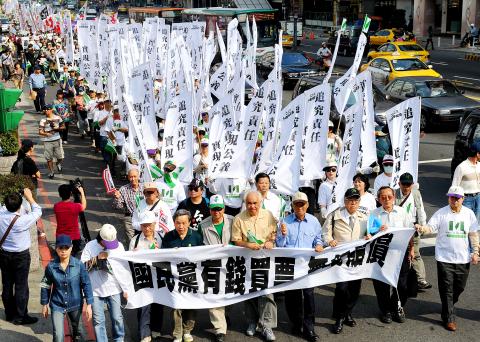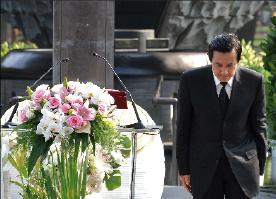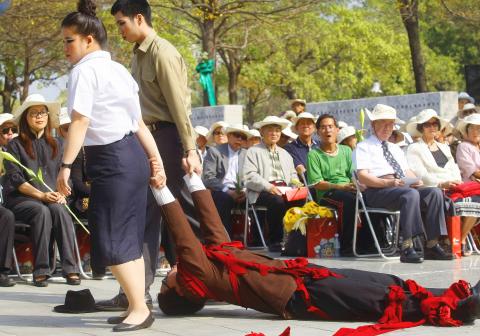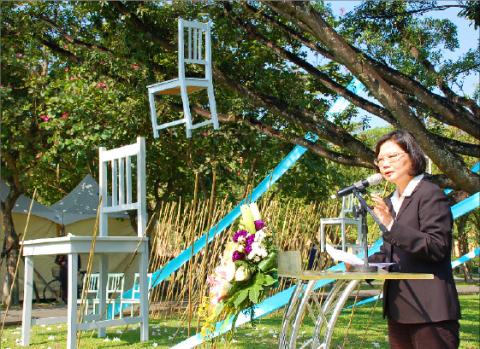|
National 228 museum opens in Taipei
NEVER FORGET:Minister of the Interior Jiang Yi-huah said
the ministry would keep reminding government offices to fly the national flag at
half-mast on Feb. 28
By Ko Shu-ling, Rich Chang and Vincent Y. Chao
/ Staff Reporters

People march in Taipei yesterday to urge the
Chinese Nationalist Party (KMT) to admit responsibility for the 228 Incident.
Photo: Liao Chen-huei, Taipei Times
The National 228 Memorial Museum opened to the public
yesterday to mark the 64th anniversary of the 228 Incident, with President Ma
Ying-jeou (馬英九) pledging to keep investigating the massacre in which thousands
of Taiwanese were killed by Chinese Nationalist Party (KMT) troops beginning on
Feb. 28, 1947.
Ma said it was appropriate for his government to address the matter, as “the
government played the leading role in the 228 Incident.”
“It is the right thing to do,” he said as he left the museum.
Located on Nanhai Road in Taipei, the museum is housed in a building that was
constructed in 1931 during the Japanese colonial era. It has served as a school
dormitory, Taiwan Provincial Assembly offices and the American Institute in
Taiwan cultural center.
Amid somber ceremonies nationwide, about 1,000 protesters, led by the Taiwan 228
Care Association and the Taiwan National Alliance, marched in Taipei to call on
the KMT to take responsibility for the 228 Incident.
Former Democratic Progressive Party (DPP) chairman Yao Chia-wen (姚嘉文), Reverend
William Luo (羅榮光) of the Presbyterian Church and World United Formosans for
Independence chairman Ng Chiau-tong (黃昭堂) led the rally.

President Ma Ying-jeou bows yesterday during a
ceremony in Taipei to honor the thousands of people killed during the 228
Incident.
Photo: Patrick Lin, AFP
The protesters, who began their march at 2:28pm at Zhongxiao
E Rd Sec 3, passed by KMT headquarters, where they chanted slogans urging the
party to accept responsibility.
Chen Yi-shen (陳儀深), an associate researcher at the Institute of Modern History
at Academia Sinica, told the rally in front of the KMT building that while the
regimes of former presidents Chiang Kai-shek (蔣介石) and Chiang Ching-kuo (蔣經國)
were no more, the KMT had not changed its nature and ideology and therefore
should shoulder full responsibility for the incident.
“We can’t say ‘just determine who the victims were.’ Those responsible for the
incident must also be revealed,” Chen said.
“Look for the perpetrators, find the truth,” some protesters chanted.
The marchers then headed for Ketagalan Boulevard in front of the Presidential
Office, where a memorial concert was held.
Chang Yen-hsien (張炎憲), chairman of the 228 Care Association and a historian
specializing in modern Taiwanese history, said that last year, 128 families of
228 Incident victims filed a lawsuit listing demands for the KMT to publicly
apologize for the massacre, publicize information relevant to the 228 Incident
held in the party’s archives and pay compensation of NT$200 million (US$67.2
million) from party assets to help with the upkeep of the 228 Memorial Hall in
Taipei.
However, the Taipei District Court ruled the massacre was ordered by the
government of the day and was not related to the KMT per se, he said, adding
that the plaintiffs have appealed to the Taiwan High Court.

Survivors of the 228 Incident and their relatives attending a
ceremony at the 228 Peace Park in Greater Kaohsiung yesterday watch a play
depicting the repression that took place during the crackdown by the
then-Chinese Nationalist Party (KMT) government.
Photo: CNA
Although compensation has been paid to many of the victims’ families, the money
came from taxpayers, not KMT coffers, he said.
The legislature in June 2009 approved an amendment to the Act for Handling and
Compensation for the 228 Incident (二 二 八事件處理及補償條例) that would require the
Executive Yuan to establish a national memorial hall to commemorate the 228
Incident.
Taiwan Solidarity Union Chairman Huang Kun-huei (黃昆輝) accused Ma of falsifying
history by saying there were no real perpetrators in the incident.
At the national memorial service at Taipei’s 228 Peace Park in the afternoon, Ma
bowed in apology for the massacre.
“As the president of the Republic of China [ROC], I am willing to apologize and
be responsible for the mistakes the government made in the past,” he said in
Hoklo (commonly known as Taiwanese).
“I am sorry for the pain that the government caused you,” he said.
Ma said that five years ago, when he was Taipei mayor, he proposed the central
government establish a national memorial hall to commemorate the 228 Incident to
show that the government attaches great importance to the tragedy and is capable
of reflecting on itself.
“It also signifies that Taiwan’s democracy is becoming more mature and that the
ROC government is one that knows how to examine its own mistakes,” he said at
the time.
History is like a mirror, he said. The incident happened when Taiwan was not yet
a democracy, but now everything is different, he said, adding that people must
take good advantage of the democratic system that has developed over time and
keep the government in check so it will not be corrupt and make the same mistake
again.
If the government and people can work together for freedom, democracy, human
rights and the rule of law, Ma said he believed similar incidents would never
occur in Taiwan.
Before Ma’s speech, a man who lost his father in the massacre drew parallels
between the 228 Incident and the mass protests that have shaken much of North
Africa and parts of the Middle East in recent weeks.
“If there had been the Internet to serve as a communications tool in 1947, the
228 Incident would have been recognized by the world, like today’s ‘Jasmine
Revolution’ in Tunisia, as a movement seeking liberty and justice,” said Chien
Ming-jen (簡明仁), president of First International Computer.
Born in March 1947, Chien said he never met his father, a teacher who was
arrested in 1950 and executed in 1951, and did not realize his family history
until he was 32 years old.
“Many would say: ‘Let’s forget the past,’ but the stigmatization and fear that
is attached to my family will take generations to erase,” he said, adding that
the government should support the families of the victims and face history with
honesty.
Premier Wu Den-yih (吳敦義) described the incident as an “unfortunate tragedy,”
saying it was “inevitable” for any individual or government to make mistakes,
but it is even more important to recognize the mistakes and make sure they will
never happen again.
Minister of the Interior Jiang Yi-huah (江宜樺) said the ministry had asked
government agencies to fly the flag of the Republic of China at half staff on
Feb. 28 to remind them of the memorial day.
“We just want them to follow the rules,” he said. “This is not the first time
government agencies have been required to do so since the measure was enacted in
2006.”
Jiang said that some government bodies might forget to do so, but they would not
be punished if they fail to comply
If his ministry can continue to remind them in the lead-up to all national
holidays, Jiang said he believed they would remember when the time comes.
He also dismissed speculation that the country’s embassies and representative
offices abroad did not have to comply, saying the rule applied everywhere.
The government has held a 228 ceremony every year since 2003 as part of efforts
to heal historical wounds through legislative or concrete acts, such as making a
formal apology and offering monetary compensation to the families of the
victims.
As part of the activities to mark 228, local governments around Taiwan lowered
the national flag to half-mast.
Meanwhile, DPP Chairperson Tsai Ing-wen (蔡英文) marked the anniversary at a
memorial event in Yilan County, where she called the massacre a “deep scar” that
did not discriminate on race or location.

Democratic Progressive Party Chairperson Tsai Ing-wen
addresses a 228 Incident memorial ceremony in Yilan County yesterday.
Photo: Yu Ming-ching, Taipei Times
Tsai gave flowers to families of the victims and also placed them on empty
chairs, to symbolize the victims who had not returned home.
“When I look at the empty chairs, I think of the empty chair left for [Chinese
dissident] Liu Xiaobo (劉曉波) at the Nobel ceremony [last December],” she said.
“It reveals just how distant Taiwan and China has become in terms of human
rights and democracy.”
Tsai said she did not believe that any group could claim the “sole rights” over
the incident, maintaining that it was a painful reminder shared by all
Taiwanese.
“There is only one 228 Incident and it belongs to neither the DPP nor the KMT.
This country needs to continue to face up to the incident together as one,” she
said.
In an open letter to the Chinese-language Apple Daily yesterday, Tsai said
politicians must continue to heed the lessons left from the 228 Incident.
“Incidents like 228 will continue to occur when politicians think not of the
people’s rights but how to keep their own political power,” she said.
“It would be sugarcoating history to say that it was an incident without a
perpetrator,” she said, referring to the controversial changes that some say
glorify the role of Chiang Kai-shek at the Taipei 228 Memorial Museum.
|
![]()
![]()